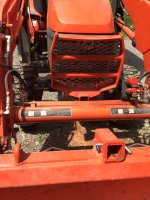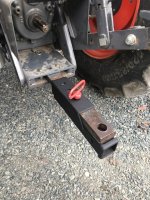You are using an out of date browser. It may not display this or other websites correctly.
You should upgrade or use an alternative browser.
You should upgrade or use an alternative browser.
Is this a reciever of some sort
- Thread starter Gasguzziler
- Start date
- Views: 2538
More options
Who Replied?
/ Is this a reciever of some sort
#11
That's prob because you have a BX. It really all depends on the trailer though. Either way the tongue height matters very little when your going 5mph through the field.Most drawbars are too low for good trailer handling. I made a clamp on receiver hitch for my FEL. I find pushing trailers to be better for maneuvering in tight spots. Got the idea watching lot boys at an RV dealer moving trailers that way with a forklift. On the FEL you are looking straight ahead to where you are going, and tight turns are easier. I have never been good at backing trailers with a PU anyway. Never enough practice. Smokey's FEL system is the wrong approach, you need to lock onto a ball hitch.
Ron
repete
Veteran Member
My choice as well.
Smokeydog
Elite Member

Wrong approach? Have a clamp-on receiver too but prefer the welded one so far.
Use the bucket receiver hitch on the B20 (23 years), B26 (4years) to move trailers with 100s yards of compost/mulch, cords of wood with pintle and ball hitches. Can load a trailer with counter weight implements on back and then move the trailer. Transport and store log splitter and concrete mixer. Particularly handy moving trailers in tight quarters. Convenient to move trailers or boat when mowing the yard. With hitch bale spear moved hundreds round bales of hay. Stretched miles of barbed wire hitch mounted unroller. Have a hitch mount carrier for the 12V sprayer. Various hitch mounted hooks, vises and shop tools. Find the bucket hitch safe and convenient. Our TLBs like the OP are tougher and stronger than their ag or homeowner counterparts.
I see a fellow on eBay that sells a plate assembly with a receiver hitch and hooks that can be bolted to the top of FEL buckets.
Fallon
Super Member
Hitching a trailer to a 3pt is potentially risky for similar reasons. The draw bar is located below the axle. If the trailer gets stuck it increases traction & stability. If the load is above the rear axle the rear tires can keep moving & literally drive out from under the tractor while the trailer hitch keeps the top if the tractor in one spot. Basicalky you can roll over backwards if your trailer hitches up over the axle. As there is no down force on as 3pt, a tongue can bounce the 3pt up causing bad high lateral forces too. Generally not an issue either way at walking speeds on flat ground. But can be risky on rough ground or hills.That's prob because you have a BX. It really all depends on the trailer though. Either way the tongue height matters very little when your going 5mph through the field.
Personally I use a ball on the end of my pallet forks. But I'm dealing with 500lbs of tongue weight on a tractor that will lift double to quadruple that. I'm also going only a hundred yards on smoothish flat ground.
repete
Veteran Member
Hitching a trailer to a 3pt is potentially risky for similar reasons. The draw bar is located below the axle. If the trailer gets stuck it increases traction & stability. If the load is above the rear axle the rear tires can keep moving & literally drive out from under the tractor while the trailer hitch keeps the top if the tractor in one spot. Basicalky you can roll over backwards if your trailer hitches up over the axle. As there is no down force on as 3pt, a tongue can bounce the 3pt up causing bad high lateral forces too. Generally not an issue either way at walking speeds on flat ground. But can be risky on rough ground or hills.
Personally I use a ball on the end of my pallet forks. But I'm dealing with 500lbs of tongue weight on a tractor that will lift double to quadruple that. I'm also going only a hundred yards on smoothish flat ground.
You will live longer while using a tractor if you first look at what can go WRONG with a plan as opposed to what can go right with a plan.
OP
Gasguzziler
New member
- Joined
- Apr 6, 2019
- Messages
- 8
- Tractor
- Kubota b21
View attachment 658751
Wrong approach? Have a clamp-on receiver too but prefer the welded one so far.
Use the bucket receiver hitch on the B20 (23 years), B26 (4years) to move trailers with 100s yards of compost/mulch, cords of wood with pintle and ball hitches. Can load a trailer with counter weight implements on back and then move the trailer. Transport and store log splitter and concrete mixer. Particularly handy moving trailers in tight quarters. Convenient to move trailers or boat when mowing the yard. With hitch bale spear moved hundreds round bales of hay. Stretched miles of barbed wire hitch mounted unroller. Have a hitch mount carrier for the 12V sprayer. Various hitch mounted hooks, vises and shop tools. Find the bucket hitch safe and convenient. Our TLBs like the OP are tougher and stronger than their ag or homeowner counterparts.
I see a fellow on eBay that sells a plate assembly with a receiver hitch and hooks that can be bolted to the top of FEL buckets.
This is what I'd like to do but the cheap bucket on here would need a lot added to it to be able to do that, for now I got a clamp on one that I just used, just been looking for alternatives.
Here is a pic of the top of my bucket, I'd have to add quite a bit of steel to be able to do that
Shared album - Michael Turpin - Google Photos
diesel85
Veteran Member
I've got a 3pt trailer mover.
It's the best and safest way to move trailers with a tractor, especially ones that have heavy tongue weights.
I cringe seeing people move trailers with skid steers and buckets on tractors, especially after some recent accidents.
In the past year, there was a RV lot that was moving campers, and the skid steer flipped over. Second one was a farmer that they were moving their heavy equipment trailer around, and they were on an incline, and the operator got ejected from the machine during a maneuver.
Not to mention the loader isn't really meant for it.
I've always been told that the weight belongs on the rear of a tractor.
Some say, oh, its too hard or something to extent. I'd rather play it safe, I've been in enough sketchy situations with machinery when I was younger.
It's the best and safest way to move trailers with a tractor, especially ones that have heavy tongue weights.
I cringe seeing people move trailers with skid steers and buckets on tractors, especially after some recent accidents.
In the past year, there was a RV lot that was moving campers, and the skid steer flipped over. Second one was a farmer that they were moving their heavy equipment trailer around, and they were on an incline, and the operator got ejected from the machine during a maneuver.
Not to mention the loader isn't really meant for it.
I've always been told that the weight belongs on the rear of a tractor.
Some say, oh, its too hard or something to extent. I'd rather play it safe, I've been in enough sketchy situations with machinery when I was younger.
Smokeydog
Elite Member
This is what I'd like to do but the cheap bucket on here would need a lot added to it to be able to do that, for now I got a clamp on one that I just used, just been looking for alternatives.
Here is a pic of the top of my bucket, I'd have to add quite a bit of steel to be able to do that
Shared album - Michael Turpin - Google Photos
That looks like the bucket on the B20. I notched the top rolled edge for a receiver hitch. Then boxed the rolled top edge on the back with pieces of 1.5” x 1/4” angle on both sides of the of the receiver tube. All welded. The added structural strength gave good service and no bending.
dstig1
Super Member
- Joined
- Apr 7, 2010
- Messages
- 5,562
- Location
- W Wisc
- Tractor
- Kubota L5240 HSTC, JD X738 Mower, (Kubota L3130 HST - sold)
I picked up one of these once it became clear that the receiver I welded to the top of bucket was way too high up to be very useful for trailers. It can be useful for other things, but not very good for moving trailers.
Load-Quip 2in. Class 3 Hitch Receiver Clamp, Model# 29211765 | Northern Tool
Works great. Very easy to control the trailer on the front like this.
Not sure if you are talking about only moving around an empty trailer or if it would be loaded, but you will want to be very careful of handling a heavy trailer with a tractor as small as a BX, especially if there are any hills/side slopes involved
Load-Quip 2in. Class 3 Hitch Receiver Clamp, Model# 29211765 | Northern Tool
Works great. Very easy to control the trailer on the front like this.
Not sure if you are talking about only moving around an empty trailer or if it would be loaded, but you will want to be very careful of handling a heavy trailer with a tractor as small as a BX, especially if there are any hills/side slopes involved

